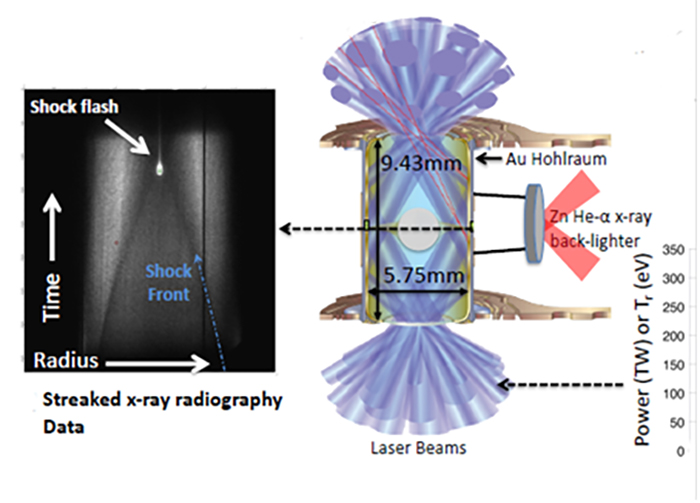Developing New Capabilities

Tracking Stellar Evolution
Every program that wants to remain on the forefront of science and technology must frequently infuse new ideas. One of the NIF & Photon Science Directorate’s key goals is developing new capabilities to meet the scientific challenges of the future.
NIF’s ability to reach the highest possible pressures in controlled laboratory experiments has launched an exciting new era of high energy density science.
To advance our laser design and engineering acumen, NIF&PS developed the petawatt-class Advanced Radiographic Capability (ARC), the world’s most energetic short-pulse laser; then built on its experience with ARC to design and construct another world-class laser, the innovative High-Repetition-Rate Advanced Petawatt Laser System (HAPLS). Now installed at the Extreme Light Infrastructure Beamlines facility in the Czech Republic, HAPLS pushes the limits of high-repetition-rate, high-average-power petawatt lasers and again shows that LLNL continues to be a world leader in innovative lasers.
In addition, NIF has the unique ability to re-create, on a vastly smaller scale, the same physical processes that astronomers can only glimpse through a telescope. Laboratory experiments on NIF help scientists gain new insights into the mechanisms driving new and dying stars, supernova hydrodynamics, black holes, cosmic magnetic fields, warm dense matter, and the interiors of giant planets (see Discovery Science).
Putting the Squeeze on Materials
Many NIF high energy density experiments are aimed at providing clues to changes in the properties of materials subjected to ultrahigh pressures.

Using NIF, researchers have developed an experimental capability for measuring the equation of state (EOS) and other basic properties of matter at pressures ranging from 100 to 450 megabars (100 to 450 million times Earth’s atmospheric pressure)—the highest pressures ever achieved in laboratory EOS measurements.
Knowing the EOS—the thermodynamic relationship between the energy content of a mass of material, its volume, and its temperature—is essential for determining how matter behaves at high energy densities. Such dynamic phase transitions can be studied in materials such as carbon, lead, iron, tantalum, and uranium. These conditions are relevant, for example, to the carbon envelopes of white dwarfs—stars that have exhausted their nuclear fuel and collapsed into hot, super-dense mixtures of carbon and oxygen.
LLNL researchers also have pioneered a technique known as ramp compression to apply a carefully tailored laser pulse shape that more “softly” compresses a material without forming a shock. NIF’s ability to tweak pulse-shaping keeps temperatures low enough to preserve the sample’s solid state.
By employing x-ray diffraction, which determines the crystal structure of solids, ramp-compressed samples can be probed by diffraction of x rays generated by a laser-driven source foil. The resulting diffraction lines provide insights into phase changes, or structural transitions, that can occur in materials under extreme pressure.
Using the unique TARDIS experimental platform, the researchers have measured x-ray diffraction to more than 20 megabars (20 million times Earth’s atmospheric pressure) to determine the crystal structure, measure the density, and evaluate the strain-induced texturing of a variety of compressed samples.
TARDIS provides important information on the characteristics of materials used in nuclear weapons as they age or are subjected to the immense pressures and temperatures of a thermonuclear explosion, as well as materials found in the center of stars and giant planets (see “NIF’s TARDIS Aims to Conquer Time and Space”).
More Information
“LLNL Joins New Research on Atom-Changing Pressures,” NIF & Photon Science News, August 27, 2020
“Record EOS Measurement Pressures Shed Light on Stellar Evolution,” NIF & Photon Science News, August 5, 2020
“New Research Finds Lead Gets Harder Under Extreme Conditions, NIF & Photon Science News, November, 2019
“Studying Matter Under Extreme Conditions,” Science & Technology Review, September, 2019
“Gently Compressing Materials to Record Levels,” Science & Technology Review, September, 2019
“Laser Experiments Illuminate the Cosmos,” Science & Technology Review, December, 2016
“Experiments Test High-Pressure Material Response,” NIF & Photon Science News, November, 2015
Under Pressure: Granular Studies with Immeasurable Implications,” Science & Technology Review, September, 2015
“From microjoules to megajoules and kilobars to gigabars: Probing matter at extreme states of deformation,” Physics of Plasmas, September 17, 2015.



